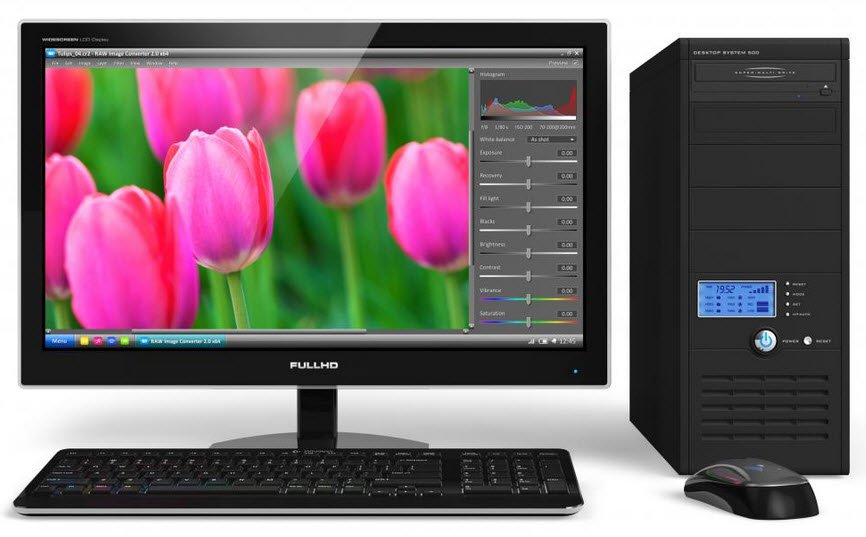
General purpose computers come in many sizes and capabilities. Traditionally, computers were classified by their size, processing speed, and cost. Based on these factors and generations, computers were classified as:
- ANALOG COMPUTERS
- DIGITAL COMPUTERS
- HYBRID COMPUTERS
- MAINFRAME COMPUTERS
- MICROCOMPUTERS
- LAPTOPS
- PERSONAL DIGITAL ASSISTANTS – PDAS
However, with rapidly changing technology, this classification is no longer relevant. The problem is that computer technology is changing so swiftly that after every few months, new models of computers are introduced having much higher performance and costing less than their preceding models.
Suggested Read:
- Computer Generations and Its Types
- List of Secondary Storage Devices
- List of Computer Output Devices You Need To Know
- List of Computer Input Devices You Need To Know
- Top 10 Computer Keyboard Shortcuts
1. ANALOG COMPUTERS
Analog computers use continuous variables for mathematical operations and utilize mechanical or electrical energy. An analog computer represents data as physical quantities and operates on the data by manipulating these quantities. Complex circuits were involved in the design of Analog computers and the circuit had to be modified for different functions performed by analog computers.

These are different from a digital computer because an analog computer can perform several tasks or mathematical operations simultaneously whereas digital computers can perform only one task or calculation at one time. Analog computers are not used these days and have been replaced by digital computers.
2. DIGITAL COMPUTERS
A digital computer is designed to process data in binary form O and 1 and it proceeds in the discrete steps from one state to another state. A digital computer can store the results of its calculations for future use,can compare the results and on the basis of such comparisons can change the series of operations it performs.

Digital computers come in a wide variety of types like desktop computer, minicomputer, mainframe and the supercomputer. Digital computers are used for scientific applications, data-processing and word-processing applications, desktop publishing, electronic games and many other purposes.
3. HYBRID COMPUTERS
Hybrid computer is a digital computer that can produce output in digital as well as analog form. A hybrid computer can also process analog data as well as digital data. It accepts continuously varying input which is then converted into a set of discrete values for digital processing.

An example of a hybrid computer is the computer used in hospitals to measure the heartbeat of the patient.Hybrid Machines are generally used in scientific applications or in controlling industrial processes.
4. MAINFRAME COMPUTERS
Mainframe computers are used by large organizations for critical applications like processing thousands of real time transactions.They operate at very high speed and have very large storage capacity. Most of the mainframe computers have the capacity to host multiple operating systems.

Mainframes support multiprocessing with hundreds of processors in one system. They occupy a large space and generate a lot of heat.
5. MICROCOMPUTERS
A computer with a microprocessor as its central processing unit is known as a microcomputer. A Microcomputer is designed for individual use and has various units attached to mainframe computers and has less processing capability than mainframe computers.

6. LAPTOPS
Laptop computers have been designed for mobile use.Laptops run on a single battery or an external adapter that changes the computer batteries. They are enabled with an in-built keyboard, touchpad acting as a mouse and a liquid crystal display.

Laptops have the same processing capability as that of desktop computers. The price of a Laptop is generally higher than desktop computers because of integrated technology.
7. PERSONAL DIGITAL ASSISTANTS – PDAS
Personal Digital assistant is a handheld computer and popularly known as a palmtop. It has a touch screen and a memory card for storage of data.

PDAs can also be effectively used as portable audio players, web browsers and smartphones. Most of them can access the Internet by means of Bluetooth or Wi-Fi communication.
You may also like:- How To Fix the Crowdstrike/BSOD Issue in Microsoft Windows
- MICROSOFT is Down Worldwide – Read Full Story
- Windows Showing Blue Screen Of Death Error? Here’s How You Can Fix It
- A Guide to SQL Operations: Selecting, Inserting, Updating, Deleting, Grouping, Ordering, Joining, and Using UNION
- Top 10 Most Common Software Vulnerabilities
- Essential Log Types for Effective SIEM Deployment
- How to Fix the VMware Workstation Error: “Unable to open kernel device ‘.\VMCIDev\VMX'”
- Top 3 Process Monitoring Tools for Malware Analysis
- CVE-2024-6387 – Critical OpenSSH Unauthenticated RCE Flaw ‘regreSSHion’ Exposes Millions of Linux Systems
- 22 Most Widely Used Testing Tools








